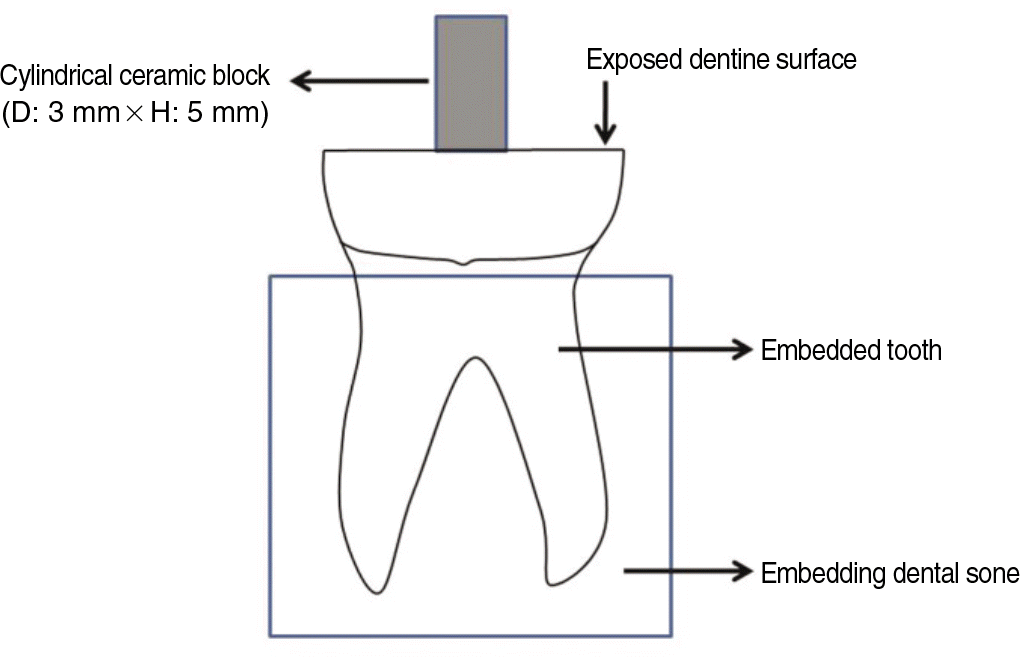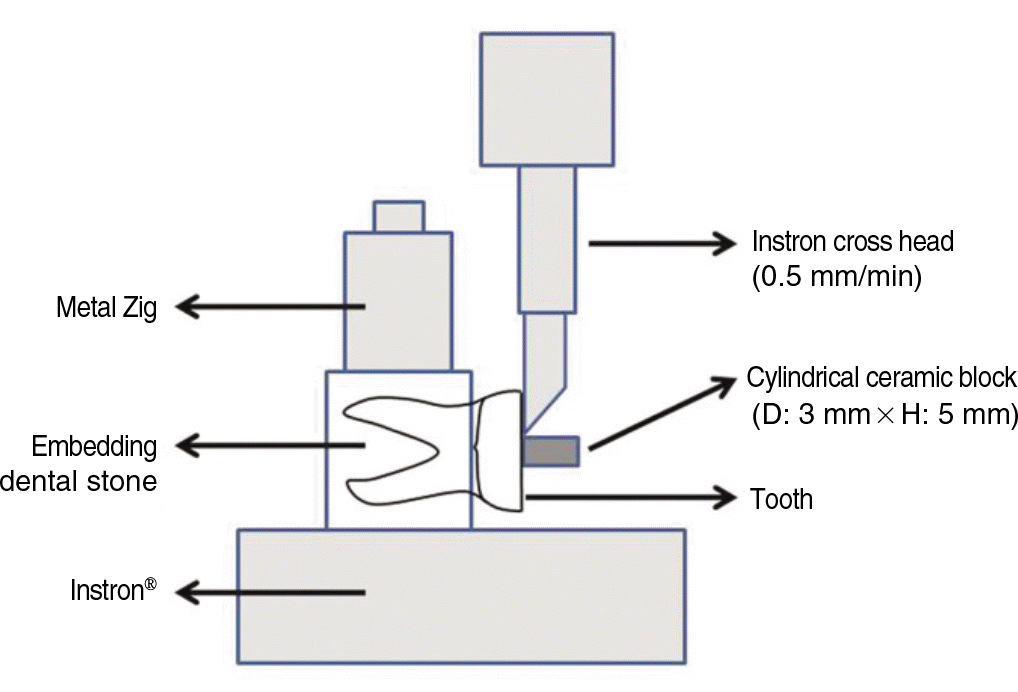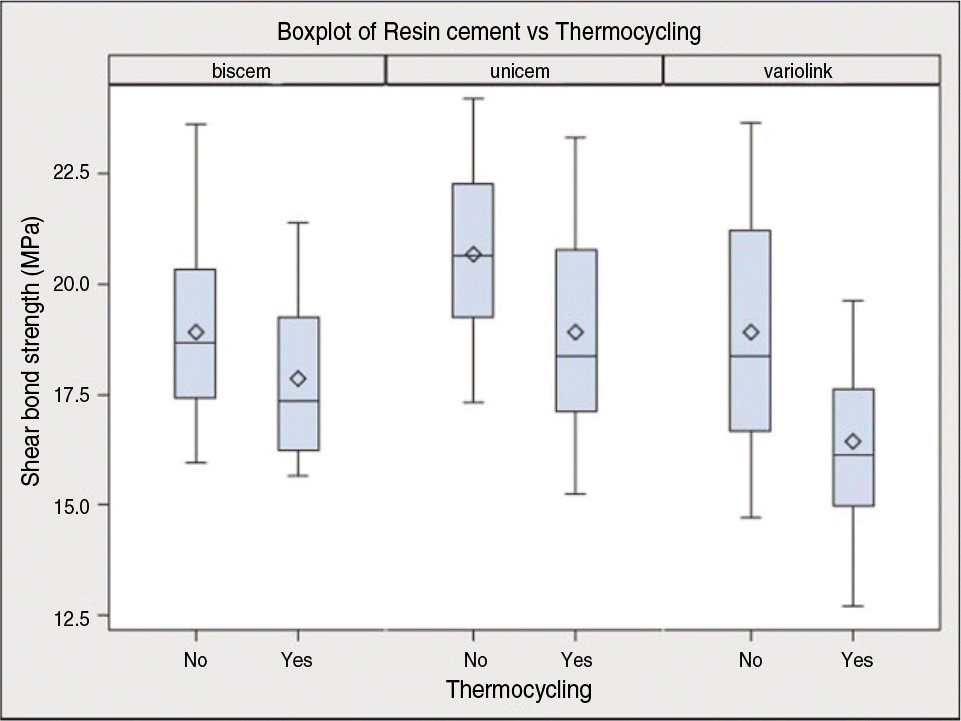Abstract
Purpose
The purpose of this study was to evaluate the bond strengths between the latest CAD/CAM ceramic inlay and various resin cements which are used primarily for esthetic restoration.
Materials and methods
Cylindrical ceramic blocks(Height: 5 mm, diameter: 3 mm) were fabricated by using Cerec3 and bonded on the dentin of the ninety extracted caries-free molars using three different kinds of resin cement(Unicem, Biscem and Variolink II according to the manufacturer's instructions. Ninety specimens were divided into 3 groups according to three different kinds of resin cement. Half of each group were conducted thermocycling under the conditions of the 5 - 55℃, 5,000 cycle but the other half of them weren't. All specimens were kept in normal saline 37℃, for 24 hours before measuring the bond strength. The shear bond strength was measured by Universal testing machine with a cross head speed of 0.5 mm/min. The results were analyzed statistically by t-test and one-way ANOVA.
Results
Unicem group showed the highest shear bond strength despite a slight decline by thermocycling. The shear bond strength of Unicemgroup and ValiolinkII group were significantly influenced by thermocycling, whereas Biscem group was not influenced (P<.05). There were no significant differences in the bond strength between the three groups without thermocycling, but there was significant differences between Unicem group and Valiolink II group with thermocycling(P<.05).
Go to : 
REFERENCES
1.Irie M., Suzuki K. Current luting cements: marginal gap formation of composite inlay and their mechanical properties. Dent Mater. 2001. 17:347–53.

2.Hayashi M., Tsuchitani Y., Kawamura Y., Miura M., Takeshige F., Ebisu S. Eight-year clinical evaluation of fired ceramic inlays. Oper Dent. 2000. 25:473–81.
3.Hayashi M., Tsuchitani Y., Miura M., Takeshige F., Ebisu S. 6-year clinical evaluation of fired ceramic inlays. Oper Dent. 1998. 23:318–26.
4.Fasbinder DJ., Dennison JB., Heys D., Neiva G. A clinical evaluation of chairside lithium disilicate CAD/CAM crowns: a two-year report. J Am Dent Assoc. 2010. 141:10S–4S.
5.Wiedhahn K. From blue to white: new high-strength material for Cerec-IPS e.max CAD LT. Int J Comput Dent. 2007. 10:79–91.
6.Diaz-Arnold AM., Vargas MA., Haselton DR. Current status of luting agents for fixed prosthodontics. J Prosthet Dent. 1999. 81:135–41.

7.Tjan AH., Dunn JR., Grant BE. Marginal leakage of cast gold crowns luted with an adhesive resin cement. J Prosthet Dent. 1992. 67:11–5.

8.White SN., Sorensen JA., Kang SK., Caputo AA. Microleakage of new crown and fixed partial denture luting agents. J Prosthet Dent. 1992. 67:156–61.

9.Han L., Okamoto A., Fukushima M., Okiji T. Evaluation of physical properties and surface degradation of self-adhesive resin cements. Dent Mater J. 2007. 26:906–14.

10.Mazzitelli C., Monticelli F., Osorio R., Casucci A., Toledano M., Ferrari M. Effect of simulated pulpal pressure on self-adhesive cements bonding to dentin. Dent Mater. 2008. 24:1156–63.

11.Moszner N., Salz U., Zimmermann J. Chemical aspects of self-etching enamel-dentin adhesives: a systematic review. Dent Mater. 2005. 21:895–910.

12.De Munck J., Vargas M., Van Landuyt K., Hikita K., Lambrechts P., Van Meerbeek B. Bonding of an auto-adhesive luting material to enamel and dentin. Dent Mater. 2004. 20:963–71.
13.Monticelli F., Osorio R., Mazzitelli C., Ferrari M., Toledano M. Limited decalcification/diffusion of self-adhesive cements into dentin. J Dent Res. 2008. 87:974–9.

14.Behr M., Hansmann M., Rosentritt M., Handel G. Marginal adaptation of three self-adhesive resin cements vs. a well-tried adhesive luting agent. Clin Oral Investig. 2009. 13:459–64.

15.D'Arcangelo C., De Angelis F., D'Amario M., Zazzeroni S., Ciampoli C., Caputi S. The influence of luting systems on the mi-crotensile bond strength of dentin to indirect resin-based composite and ceramic restorations. Oper Dent. 2009. 34:328–36.
16.Mo¨rmann W., Wolf D., Ender A., Bindl A., Go¨hring T., Attin T. Effect of two self-adhesive cements on marginal adaptation and strength of esthetic ceramic CAD/CAM molar crowns. J Prosthodont. 2009. 18:403–10.
17.Sarr M., Mine A., De Munck J., Cardoso MV., Kane AW., Vreven J., Van Meerbeek B., Van Landuyt KL. Immediate bonding effectiveness of contemporary composite cements to dentin. Clin Oral Investig. 2010. 14:569–77.

18.Piwowarczyk A., Bender R., Ottl P., Lauer HC. Long-term bond between dual-polymerizing cementing agents and human hard dental tissue. Dent Mater. 2007. 23:211–7.

19.Lu¨hrs AK., Guhr S., Gu¨nay H., Geurtsen W. Shear bond strength of self-adhesive resins compared to resin cements with etch and rinse adhesives to enamel and dentin in vitro. Clin Oral Investig. 2010. 14:193–9.
20.Bitter K., Paris S., Pfuertner C., Neumann K., Kielbassa AM. Morphological and bond strength evaluation of different resin cements to root dentin. Eur J Oral Sci. 2009. 117:326–33.

21.Hikita K., Van Meerbeek B., De Munck J., Ikeda T., Van Landuyt K., Maida T., Lambrechts P., Peumans M. Bonding effectiveness of adhesive luting agents to enamel and dentin. Dent Mater. 2007. 23:71–80.

22.Flury S., Lussi A., Peutzfeldt A., Zimmerli B. Push-out bond strength of CAD/CAM-ceramic luted to dentin with self-adhesive resin cements. Dent Mater. 2010. 26:855–63.

23.Radovic I., Monticelli F., Goracci C., Vulicevic ZR., Ferrari M. Self-adhesive resin cements: a literature review. J Adhes Dent. 2008. 10:251–8.
24.Viotti RG., Kasaz A., Pena CE., Alexandre RS., Arrais CA., Reis AF. Microtensile bond strength of new self-adhesive luting agents and conventional multistep systems. J Prosthet Dent. 2009. 102:306–12.

25.Brunzel S., Yang B., Wolfart S., Kern M. Tensile bond strength of a so-called self-adhesive luting resin cement to dentin. J Adhes Dent. 2010. 12:143–50.
26.Holderegger C., Sailer I., Schuhmacher C., Schla¨pfer R., Ha¨- mmerle C., Fischer J. Shear bond strength of resin cements to human dentin. Dent Mater. 2008. 24:944–50.

27.Gale MS., Darvell BW. Thermal cycling procedures for labora- tory testing of dental restorations. J Dent. 1999. 27:89–99.
28.Ernst CF., Euler T., Willershausen B. Approximal temperature increase and decrease during thermocycling in vivo. J Dent Res. 1997. Special Issue, Abstr 231: 42.
Go to : 
Table 1.
Composition of resin cements used in this study
| Resin cement | Main composition | Manufacturer |
|---|---|---|
| Unicem® | methacrylate monomers containing phosphoric acid groups, silanated fillers | 3M ESPE, USA |
| Biscem® | Bis (hydroxyethyl methacrylate) phosphate (base); tetraethylene glycol dimethacrylate; dental glass | Bisco, USA |
| Variolink II® | Bis-GMA+, TEGDMA++, UDMA+++ | Ivoclar Vivadent, Liechtenstein |
Table 2.
Mean and Standard variation of the shear bond strength (MPa) of all groups with/without thermocycling (Mean ± SD)
| Thermocycling | Resin cement | ||
|---|---|---|---|
| Unicem® | Biscem® | Variolink II® | |
| No | 20.67 ± 1.98 | 18.93 ± 2.09 | 18.91 ± 2.69 |
| Yes | 18.93 ± 2.40 | 17.85 ± 1.91 | 16.43 ± 2.01 |
Table 3.
T-test of Unicem®, Biscem®, and Variolink II® with/without thermocycling
| Group | t value | P-value∗ |
|---|---|---|
| Unicem® | 2.17 | .039 |
| Biscem® | 1.47 | .153 |
| Variolink II® | 2.86 | .008 |
Table 4.
One-way ANOVA for shear bond strength without thermocycling
| Source | DF | Sum of squares | Mean square | F value | P-value |
|---|---|---|---|---|---|
| Resin cement | 2 | 30.779 | 15.389 | ||
| Error | 42 | 217.140 | 5.170 | 2.98 | .062 |
| Total | 44 | 247.919 |




 PDF
PDF ePub
ePub Citation
Citation Print
Print





 XML Download
XML Download